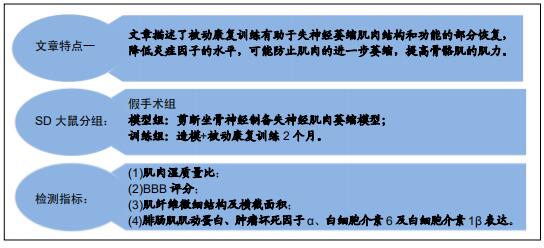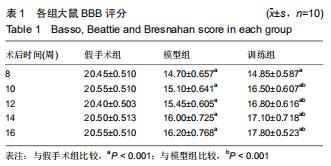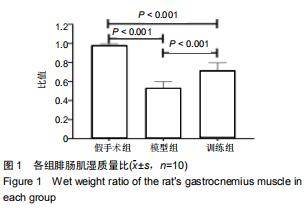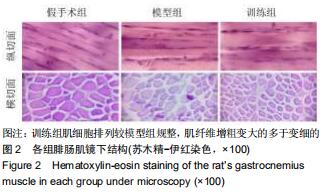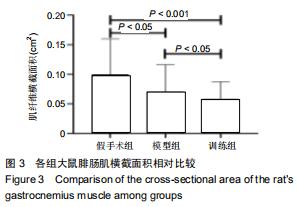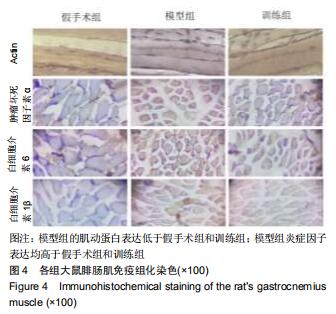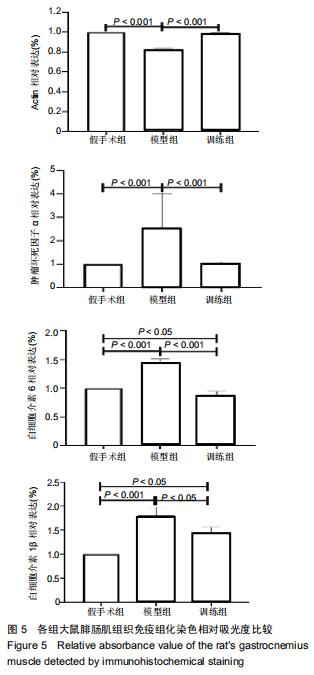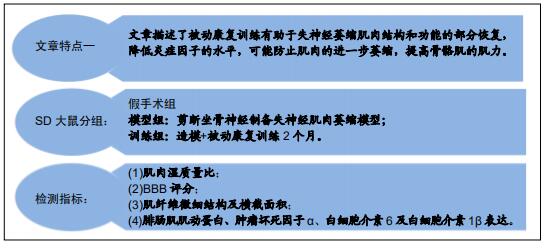|
[1] BOSKOVSKI MT, THOMSON JG. Carpal tunnel syndrome, syndrome of partial thenar atrophy, and W. Russell Brain: a historical perspective. J Hand Surg Am. 2014;39(9): 1822-1829 e1.
[2] JUNQUERA L, GALLEGO L.Images in clinical medicine. Denervation atrophy of the tongue after hypoglossal-nerve injury. N Engl J Med. 2012;367(2):156.
[3] NADERI J, BERNREUTHER C, GRABINSKI N. Plasminogen activator inhibitor type 1 up-regulation is associated with skeletal muscle atrophy and associated fibrosis. Am J Pathol. 2009;175(2):763-771.
[4] AGUERA E, CASTILLA S, LUQUE E.Denervated muscle extract promotes recovery of muscle atrophy through activation of satellite cells. An experimental study. J Sport Health Sci. 2019;8(1):23-31.
[5] GIGER JM, BODELL PW, ZENG M. Rapid muscle atrophy response to unloading: pretranslational processes involving MHC and actin. J Appl Physiol (1985). 2009;107(4): 1204-1212.
[6] WADA E, TANIHATA J, IWAMURA A.Treatment with the anti-IL-6 receptor antibody attenuates muscular dystrophy via promoting skeletal muscle regeneration in dystrophin-/utrophin-deficient mice. Skelet Muscle. 2017; 7(1):23.
[7] WEI J, LIANG BS. PPM1B and P-IKKbeta expression levels correlated inversely with rat gastrocnemius atrophy after denervation. Braz J Med Biol Res.2012;45(8): 711-715.
[8] HILLEN BK, YAMAGUCHI GT, ABBAS JJ, et al. Joint-specific changes in locomotor complexity in the absence of muscle atrophy following incomplete spinal cord injury. J Neuroeng Rehabil. 2013;10:97.
[9] MA W, ZHANG R, HUANG Z, et al. PQQ ameliorates skeletal muscle atrophy, mitophagy and fiber type transition induced by denervation via inhibition of the inflammatory signaling pathways. Ann Transl Med.2019;7(18): 440.
[10] JIANG GL, GU YD, ZHANG LY. Randomized, double-blind, and placebo-controlled trial of clenbuterol in denervated muscle atrophy. ISRN Pharm. 2011;2011:981254.
[11] HORII N, UCHIDA M, HASEGAWA N. Resistance training prevents muscle fibrosis and atrophy via down-regulation of C1q-induced Wnt signaling in senescent mice. FASEB J. 2018;32(7):3547-3559.
[12] HUANG Z, FANG Q, MA W. Skeletal Muscle Atrophy Was Alleviated by Salidroside Through Suppressing Oxidative Stress and Inflammation During Denervation. Front Pharmacol. 2019;10:997.
[13] WENG J, WANG YH, LI M, et al. GSK3β inhibitor promotes myelination and mitigates muscle atrophy after peripheral nerve injury. Neural Regen Res. 2018;13(2):324-330.
[14] 李枚原,薛成斌,韦中亚.大鼠失神经支配后比目鱼肌和趾长伸肌超微结构变化的实验研究[J].交通医学,2011,25(2):107-109.
[15] 董进,柯棠山,刘坤祥.大鼠失神经不同时相的骨骼肌形态和MyoD表达变化[J].现代医药卫生. 2015,36(8):1124-6+30.
[16] SZCZEPANOWSKA J, BOROVIKOV YS, JAKUBIEC-PUKA A. Effects of denervation and muscle inactivity on the organization of F-actin. Muscle Nerve. 1998;21(3):309-317.
[17] RILEY DA, BAIN JL, THOMPSON JL. Disproportionate loss of thin filaments in human soleus muscle after 17-day bed rest. Muscle Nerve. 1998;21(10):1280-1289.
[18] TAMAKI H, YOTANI K, OGITA F. Electrical Stimulation of Denervated Rat Skeletal Muscle Ameliorates Bone Fragility and Muscle Loss in Early-Stage Disuse Musculoskeletal Atrophy. Calcif Tissue Int. 2017;100(4):420-430.
[19] THEILEN NT, JEREMIC N, WEBER GJ. Exercise preconditioning diminishes skeletal muscle atrophy after hindlimb suspension in mice. J Appl Physiol (1985). 2018; 125(4):999-1010.
[20] NAKAGAWA K, TAMAKI H, HAYAO K. Electrical Stimulation of Denervated Rat Skeletal Muscle Retards Capillary and Muscle Loss in Early Stages of Disuse Atrophy. Biomed Res Int. 2017;2017:5695217.
[21] FINNI T, HODGSON JA, LAI AM. Mapping of movement in the isometrically contracting human soleus muscle reveals details of its structural and functional complexity. J Appl Physiol (1985). 2003;95(5):2128-2133.
[22] HADDAD F, ZALDIVAR F, COOPER DM. IL-6-induced skeletal muscle atrophy. J Appl Physiol (1985). 2005;98(3): 911-917.
[23] MA W, ZHANG R, HUANG Z. PQQ ameliorates skeletal muscle atrophy, mitophagy and fiber type transition induced by denervation via inhibition of the inflammatory signaling pathways. Ann Transl Med. 2019;7(18):440.
[24] WU C, TANG L, NI X. Salidroside Attenuates Denervation-Induced Skeletal Muscle Atrophy Through Negative Regulation of Pro-inflammatory Cytokine. Front Physiol. 2019;10:665.
[25] AL-NASSAN S, FUJITA N, KONDO H. Chronic Exercise Training Down-Regulates TNF-alpha and Atrogin-1/MAFbx in Mouse Gastrocnemius Muscle Atrophy Induced by Hindlimb Unloading. Acta Histochem Cytochem. 2012;45(6):343-349.
[26] HE Q, QIU J, DAI M. MicroRNA-351 inhibits denervation-induced muscle atrophy by targeting TRAF6. Exp Ther Med. 2016;12(6):4029-4034.
[27] ZHOU L, HUANG Y, XIE H. Buyang Huanwu Tang improves denervation-dependent muscle atrophy by increasing ANGPTL4, and increases NF-kappaB and MURF1 levels. Mol Med Rep. 2018;17(3):3674-3680.
[28] OBERBACH A, LEHMANN S, KIRSCH K. Long-term exercise training decreases interleukin-6 (IL-6) serum levels in subjects with impaired glucose tolerance: effect of the -174G/C variant in IL-6 gene. Eur J Endocrinol. 2008;159(2): 129-136.
[29] MAMMEN AL, SARTORELLI V. IL-6 Blockade as a Therapeutic Approach for Duchenne Muscular Dystrophy. EBioMedicine. 2015;2(4):274-275.
[30] MIYAGI MY, SEELAENDER M, CASTOLDI A. Long-term aerobic exercise protects against cisplatin-induced nephrotoxicity by modulating the expression of IL-6 and HO-1. PLoS One. 2014;9(10):e108543.
[31] MADARO L, PASSAFARO M, SALA D. Denervation-activated STAT3-IL-6 signalling in fibro-adipogenic progenitors promotes myofibres atrophy and fibrosis. Nat Cell Biol. 2018; 20(8):917-927.
[32] SISHI BJ, ENGELBRECHT AM. Tumor necrosis factor alpha (TNF-alpha) inactivates the PI3-kinase/PKB pathway and induces atrophy and apoptosis in L6 myotubes. Cytokine. 2011;54(2):173-184.
[33] KERN H, HOFER C, LOEFLER S. Atrophy, ultra-structural disorders, severe atrophy and degeneration of denervated human muscle in SCI and Aging. Implications for their recovery by Functional Electrical Stimulation, updated 2017. Neurol Res. 2017;39(7):660-666.
[34] IMASAKA K I, TOMITA Y, NISHIJIMA T, et al. Pectoral Muscle Atrophy After Axillary Artery Cannulation for Aortic Arch Surgery . Semin Thorac Cardiovasc Surg.2019; 31(3): 414-21.
[35] HAMANO N, YAMAMOTO A, SHITARA H, et al. Does successful rotator cuff repair improve muscle atrophy and fatty infiltration of the rotator cuff? A retrospective magnetic resonance imaging study performed shortly after surgery as a reference. J Shoulder Elbow Surg.2017;26(6): 967-974.
[36] RUVEN C, LI W, LI H, et al. Transplantation of Embryonic Spinal Cord Derived Cells Helps to Prevent Muscle Atrophy after Peripheral Nerve Injury. Int J Mol Sci.2017;18(3):
[37] GU S, SHEN Y, XU W, et al. Application of fetal neural stem cells transplantation in delaying denervated muscle atrophy in rats with peripheral nerve injury. Microsurgery.2010;30(4): 266-274.
[38] ZHANG PX, HAN N, KOU YH, et al. Tissue engineering for the repair of peripheral nerve injury. Neural Regen Res. 2019; 14(1):51-58.
[39] MOIMAS S, NOVATI F, RONCHI G, et al. Effect of vascular endothelial growth factor gene therapy on post-traumatic peripheral nerve regeneration and denervation-related muscle atrophy. Gene Ther.2013; 20(10): 1014-1021.
[40] SCHAKMAN O, THISSEN J P. Gene therapy with anabolic growth factors to prevent muscle atrophy. Curr Opin Clin Nutr Metab Care.2006; 9(3): 207-13.
[41] ITOH Y, MURAKAMI T, MORI T, et al. Training at non-damaging intensities facilitates recovery from muscle atrophy. Muscle Nerve.2017; 55(2): 243-253.
[42] PANISSET M G, GALEA M P, EL-ANSARY D. Does early exercise attenuate muscle atrophy or bone loss after spinal cord injury?. Spinal Cord.2016;54(2): 84-92.
[43] RABELO M, DE MOURA JUCA R V B, LIMA L A O, et al. Overview of FES-Assisted Cycling Approaches and Their Benefits on Functional Rehabilitation and Muscle Atrophy. Adv Exp Med Biol.2018;1088:561-583.
|
